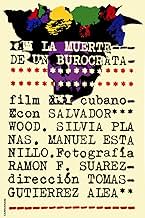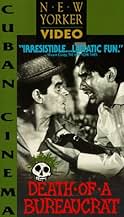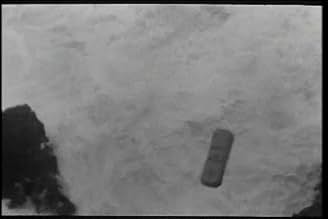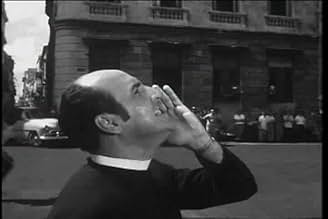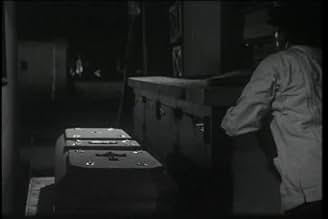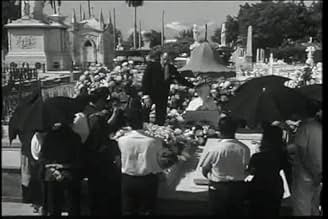ÉVALUATION IMDb
7,6/10
1,6 k
MA NOTE
Ajouter une intrigue dans votre langueA young man attempts to fight the system in an entertaining account of bureaucracy amok and the tyranny of red tape.A young man attempts to fight the system in an entertaining account of bureaucracy amok and the tyranny of red tape.A young man attempts to fight the system in an entertaining account of bureaucracy amok and the tyranny of red tape.
- Prix
- 1 victoire et 1 nomination au total
Avis en vedette
When lent this film by a Spanish professor, my expectations were not high -- I had no idea this film from the early years of revolutionary Cuba was by Gutierrez Alea, Tinton, the director of Strawberries and Chocalate. Now, having seen the film, I wonder how it is that such a wonderful, imaginative work is not better known. For a good laugh, this can hardly be beat.
"Death of a Bureaucrat"(Muerte de un burocrata) is the story of a body that just can't get in the ground, and the frustrations suffered by the deceased's family in trying to address this situation. With the themes of bureaucratic rigidity, death, burial and the challenges of (then) modern-day Cuban life, we see linkages to Tinton's last work, "Guantanamera". The director has played with a range of techniques borrowed from some of the greats -- we find Bunuel's dream sequences, Chaplin's battles with the machine, and Keaton's daring-do. Hopefully, with the success of Tinton's final works, some of his earlier works will come into vogue.
"Death of a Bureaucrat"(Muerte de un burocrata) is the story of a body that just can't get in the ground, and the frustrations suffered by the deceased's family in trying to address this situation. With the themes of bureaucratic rigidity, death, burial and the challenges of (then) modern-day Cuban life, we see linkages to Tinton's last work, "Guantanamera". The director has played with a range of techniques borrowed from some of the greats -- we find Bunuel's dream sequences, Chaplin's battles with the machine, and Keaton's daring-do. Hopefully, with the success of Tinton's final works, some of his earlier works will come into vogue.
Although I have consciously kept my foreign film viewing to a minimum during this Christmas season, I couldn't resist purchasing this one (whose release on R2 DVD from Network came literally out of left field) and watching it instantly, given its opening dedication to many an exponent of cinema (more on this later). As far as I can recall, it also marks my introduction to Cuban cinema which, as can be surmised by the title, deals with the country's social structure; considering the political situation of the time in which it was made, this is hardly a surprise
but, what is unexpected is the fact that it treats the subject matter as black comedy!
The plot resolves itself in a succession of ironic developments with respect to the pension coming to the widowed wife of a veritable working-class hero (his sculpting endeavors and unfortunate demise are depicted via a stylized animation sequence): to get it, she needs her husband's union card but his equally proletarian comrades had it buried with him as a symbolic gesture. Her milquetoast nephew, who's really the hero of the film, decides to have the body exhumed but, officially, two years have to pass before this can be legitimately done; so, he hires two men to steal the body and then proposes to have it buried once more but, since there's no record of it having been exhumed in the first place, technically, this isn't possible either. And so on and so forth, with numerous episodes involving legal red tape (which ought to bring a smile and a strong sense of empathy to anyone who has ever dealt with a government entity) until the young man is literally driven to madness and murder! The film, then, ends with the funeral of this other bureaucrat
Going back to that dedication I mentioned earlier, the full text (typed on screen along with the film's full credits at the very beginning and signed by the director) reads thus: "The film is dedicated to Luis Bunuel, Oliver Hardy, Stan Laurel, Ingmar Bergman, Harold Lloyd, Akira Kurosawa, Orson Welles, Juan Carlos Tabio, Elia Kazan, Buster Keaton, Jean Vigo, Marilyn Monroe and all those who, in one way or another, have taken part in the film industry since the days of Lumiere." This is no faint praise, either, as THE DEATH OF A BUREAUCRAT features a handful of Bunuelian dream sequences and a general mockery of Christian burial services (one highly amusing little scene is when the nephew pilfers ice cubes for his drink from his aunt's supply who is forever breaking ice in order to preserve her husband's body!); a delightful tit-for-tat routine of wanton destruction occurring, of all places, at the cemetery (and which even develops into a Laurel & Hardy-style custard pie fight!); and, at one point, we're also treated to some Harold Lloyd-type antics on a ledge when our hero finds himself locked inside an office building!
Director Tomas Gutierrez Alea is himself generally considered to be the finest Cuban film-maker and among his other works worth mentioning are THE TWELVE CHAIRS (1962; which is also available on R2 DVD from Network and the 1970 Mel Brooks version of which, incidentally, I've just acquired), MEMORIES OF UNDERDEVELOPMENT (1968), THE LAST SUPPER (1976) and the Oscar nominated STRAWBERRY AND CHOCOLATE (1994); the local DVD shop has the latter available for rental and, as a result of this positive experience with Cuban cinema, I will certainly be giving it a spin one of these days
The plot resolves itself in a succession of ironic developments with respect to the pension coming to the widowed wife of a veritable working-class hero (his sculpting endeavors and unfortunate demise are depicted via a stylized animation sequence): to get it, she needs her husband's union card but his equally proletarian comrades had it buried with him as a symbolic gesture. Her milquetoast nephew, who's really the hero of the film, decides to have the body exhumed but, officially, two years have to pass before this can be legitimately done; so, he hires two men to steal the body and then proposes to have it buried once more but, since there's no record of it having been exhumed in the first place, technically, this isn't possible either. And so on and so forth, with numerous episodes involving legal red tape (which ought to bring a smile and a strong sense of empathy to anyone who has ever dealt with a government entity) until the young man is literally driven to madness and murder! The film, then, ends with the funeral of this other bureaucrat
Going back to that dedication I mentioned earlier, the full text (typed on screen along with the film's full credits at the very beginning and signed by the director) reads thus: "The film is dedicated to Luis Bunuel, Oliver Hardy, Stan Laurel, Ingmar Bergman, Harold Lloyd, Akira Kurosawa, Orson Welles, Juan Carlos Tabio, Elia Kazan, Buster Keaton, Jean Vigo, Marilyn Monroe and all those who, in one way or another, have taken part in the film industry since the days of Lumiere." This is no faint praise, either, as THE DEATH OF A BUREAUCRAT features a handful of Bunuelian dream sequences and a general mockery of Christian burial services (one highly amusing little scene is when the nephew pilfers ice cubes for his drink from his aunt's supply who is forever breaking ice in order to preserve her husband's body!); a delightful tit-for-tat routine of wanton destruction occurring, of all places, at the cemetery (and which even develops into a Laurel & Hardy-style custard pie fight!); and, at one point, we're also treated to some Harold Lloyd-type antics on a ledge when our hero finds himself locked inside an office building!
Director Tomas Gutierrez Alea is himself generally considered to be the finest Cuban film-maker and among his other works worth mentioning are THE TWELVE CHAIRS (1962; which is also available on R2 DVD from Network and the 1970 Mel Brooks version of which, incidentally, I've just acquired), MEMORIES OF UNDERDEVELOPMENT (1968), THE LAST SUPPER (1976) and the Oscar nominated STRAWBERRY AND CHOCOLATE (1994); the local DVD shop has the latter available for rental and, as a result of this positive experience with Cuban cinema, I will certainly be giving it a spin one of these days
10ar656
This film is not just superb, but it is also a homage to movies in general.
This is a comedy, a tragedy, a parody, and a documentary. Why is this film so important to people who have never lived in Cuba? Because, like every work of art from the beginning of civilization, it is applicable the old Arab saying of "write about your street, and you will be writing about the world." Anyone who has ever dealt with the Tax Office, the Immigration Board, the City Bylaws Enforcement, the European Union office of standards, the Human Resources Department, the Phone Company, the Big Bank, the Insurance Company, or any other office of some big organization will immediately recognize the situations shown in this film.
A must see.
This is a comedy, a tragedy, a parody, and a documentary. Why is this film so important to people who have never lived in Cuba? Because, like every work of art from the beginning of civilization, it is applicable the old Arab saying of "write about your street, and you will be writing about the world." Anyone who has ever dealt with the Tax Office, the Immigration Board, the City Bylaws Enforcement, the European Union office of standards, the Human Resources Department, the Phone Company, the Big Bank, the Insurance Company, or any other office of some big organization will immediately recognize the situations shown in this film.
A must see.
Those of us who have been frustrated by trying to get large organizations (whether private or public) to take action might well enjoy Tomas Alea's Death of a Bureaucrat (1966), said to be a satire on communism / socialism, but which could equally apply to big business or the civil service / local government.
After a well-regarded worker has died (in a ludicrous accident recalling Modern Times and looking like an influence on Monty Python), his widow (Silvia Planas) and nephew (Salvador Wood) go to arrange for her pension. Unfortunately, his union card has been buried with the fellow, and nothing can be done without it. So, off goes the nephew to arrange an exhumation. Oh, no, you have to wait two years for that one! In desperation the poor fellow hires a group of chaps to sneak into the cemetery and open the coffin, but of course this goes wrong too, and our hero ends up with a coffin and a corpse on his hands. Being an honest fellow, he explains the situation but is told Uncle can't be buried without an exhumation order...
Very funny at times, this film has nods to Chaplin, Laurel and Hardy, Bunuel, Harold Lloyd and Keaton (all acknowledged) in a mixture of satire and slapstick which follows the poor chap into an ever-confused mass of paperwork, unhelpful officials and rules designed to frustrate and infuriate the gentlest of souls. At almost every turn one sees people shifting great masses of documents or passing responsibility onto other workers in scenes reminiscent of the 'Office of Circumlocution' in Dickens's Bleak House. Either that or doing things which have no relation to what they are supposed to do.
This is certainly worth a look.
After a well-regarded worker has died (in a ludicrous accident recalling Modern Times and looking like an influence on Monty Python), his widow (Silvia Planas) and nephew (Salvador Wood) go to arrange for her pension. Unfortunately, his union card has been buried with the fellow, and nothing can be done without it. So, off goes the nephew to arrange an exhumation. Oh, no, you have to wait two years for that one! In desperation the poor fellow hires a group of chaps to sneak into the cemetery and open the coffin, but of course this goes wrong too, and our hero ends up with a coffin and a corpse on his hands. Being an honest fellow, he explains the situation but is told Uncle can't be buried without an exhumation order...
Very funny at times, this film has nods to Chaplin, Laurel and Hardy, Bunuel, Harold Lloyd and Keaton (all acknowledged) in a mixture of satire and slapstick which follows the poor chap into an ever-confused mass of paperwork, unhelpful officials and rules designed to frustrate and infuriate the gentlest of souls. At almost every turn one sees people shifting great masses of documents or passing responsibility onto other workers in scenes reminiscent of the 'Office of Circumlocution' in Dickens's Bleak House. Either that or doing things which have no relation to what they are supposed to do.
This is certainly worth a look.
10Aw-komon
Forget post-revolutionary Cuba; right here in America, in 2000, there is enough bureaucracy for the comedic lessons of Alea's great film about people's propensity to conform at all costs to absurd restrictions from 'above' and cause misery to others rather than risk the slightest insecurity to themselves, to be driven home painfully. This is a really funny film but one that makes you think, like Tati's 'Playtime,' Fellini's early films or some of Bunuel's. This film is deeply critical and ridicules everything that is part and parcel of government enforced socialism. You can't fault Castro for not having a sense of humor, if he agreed to release this film. Leo Beower's understated music is, as always, excellent.
Le saviez-vous
- AnecdotesThe girl who plays the girl n the black bikini with a hammer in the "Death to Bureaucracy" parade is Regina Amador, top model at Tropicana Club Havana, Cuba 1962-1968.
- Générique farfeluDedicated to Luis Buñuel, Stan Laurel and Oliver Hardy, Ingmar Bergman, Harold Lloyd, Akira Kurosawa, Orson Welles (as Orson Wells), Juan Carlos Tabio, Elia Kazan, Buster Keaton, Jean Vigo, Marilyn Monroe.
- Bandes originalesCoja el paso
Written by Frank Dominguez
Meilleurs choix
Connectez-vous pour évaluer et surveiller les recommandations personnalisées
- How long is Death of a Bureaucrat?Propulsé par Alexa
Détails
- Date de sortie
- Pays d’origine
- Langue
- Aussi connu sous le nom de
- Death of a Bureaucrat
- Lieux de tournage
- La Habana, Cuba(town of the action)
- société de production
- Consultez plus de crédits d'entreprise sur IMDbPro
Box-office
- Brut – à l'échelle mondiale
- 3 323 $ US
- Durée1 heure 25 minutes
- Couleur
- Mixage
- Rapport de forme
- 1.66 : 1
Contribuer à cette page
Suggérer une modification ou ajouter du contenu manquant

Lacune principale
By what name was La muerte de un burócrata (1966) officially released in Canada in English?
Répondre
